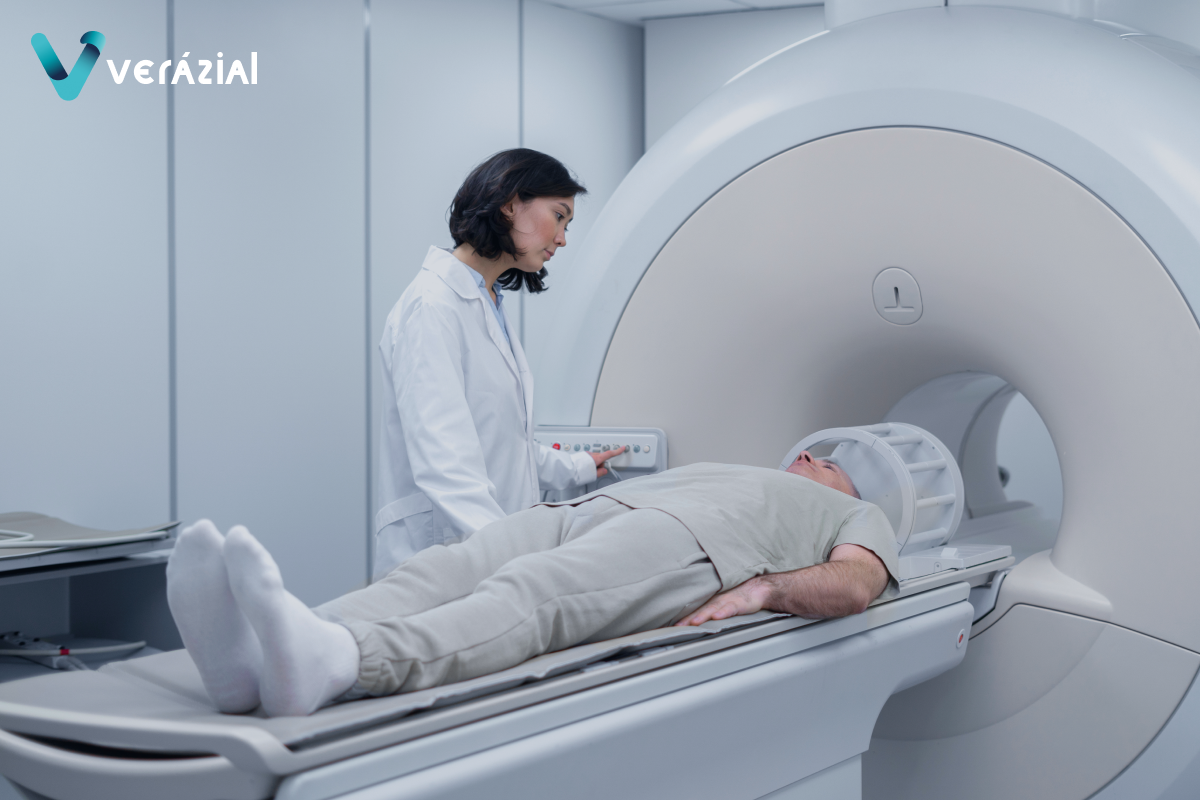Patient Identification Wristbands: Are they enough to ensure Patient Safety?
Correct patient identification is essential to avoid errors that compromise patient safety. While patient ID wristbands are a common method, they have limitations. The integration of biometric technologies offers a precise and reliable solution that complements and enhances security in identification processes, ultimately improving the quality of medical care.
In hospital settings, one of the core principles is to ensure patient safety and avoid harm. However, basic errors—like incorrect identification—still occur daily, even in advanced healthcare systems, leading to serious clinical, ethical, and economic consequences.
Among the most widely used patient identification methods are wristbands or ID bracelets. Their use responds to the need for a visible, practical, and accessible tool to ensure that each patient receives the correct treatment. These bands typically include information such as the patient’s full name, date of birth, medical record number, and in some cases, a barcode or chip for digital reading.
Wristbands are usually issued during hospital admission, when administrative staff collect the patient’s data, generate a record, and link it to a wristband. However, this process is vulnerable to human errors, such as incorrect data entry or assigning the wristband to a duplicate or overlapping record—risks that can lead to significant clinical consequences. From that point on, the wristband remains with the patient throughout their stay and serves as both a visual and digital reference in clinical procedures.
Nevertheless, their use is largely limited to inpatients. In most outpatient procedures—such as chemotherapy sessions, radiotherapy, or specialist consultations, which now represent an increasing portion of healthcare services—ID wristbands are not used. In these cases, identification relies solely on verbal or paper-based verification, significantly increasing the risk of error.
Wristbands have contributed to reducing identification errors in clinical environments. However, while they are useful, they are neither definitive nor foolproof. A wristband can be placed on the wrong patient, lost, damaged, or simply not used in certain clinical contexts—all of which present ongoing risks to accurate patient identification.
Limitations and Consequences of Relying Solely on Medical Wristbands
Although wristbands represent an improvement over traditional methods such as verbal or paper-based identification, they present several limitations that compromise both patient safety and the reliability of clinical processes.
Key limitations include:
- Admission errors: If the patient’s data is entered incorrectly from the beginning—due to human error or inaccurate verbal identification—the wristband will be linked to the wrong record. This mistake carries through the entire care process.
- Incorrect placement or accidental swaps: Wristbands can be placed on the wrong patient, particularly in high-pressure environments or among patients with similar names. They can also be easily removed or switched—especially among pediatric or cognitively impaired patients.
- Physical damage or printing issues: Wristbands can be torn, soiled, or broken, making them difficult to read both visually and digitally. Poor printing may also render them unusable from the outset.
- Lack of use in specific contexts: In many outpatient settings (e.g., consultations, chemotherapy, or radiotherapy), wristbands are not used—leaving patients without a clear and secure form of identification.
- They do not prevent identity fraud: A person can enter a healthcare facility using false or stolen information. If a wristband is issued with this incorrect identity, it validates and perpetuates the error, creating invalid medical records that can affect treatment and future care decisions.
- They do not prevent duplicate medical records: If a patient’s record cannot be found, a new one may be created with incorrect information—leading to fragmented clinical data and traceability issues.
- Clinical or physical restrictions: Some patients cannot wear wristbands due to swelling, wounds, casts, or burns. In cases where patients are unconscious or disoriented upon admission, it’s not always possible to confirm their identity or create an accurate medical record right away.

Institutional and Clinical Consequences
These limitations don’t just result in isolated operational issues—they have far-reaching implications for the entire healthcare system. When identification is inaccurate from the outset, the consequences can escalate quickly:
- Patient safety is compromised: Incorrect identification can lead to misdiagnoses, inappropriate treatments, and even unnecessary interventions—posing physical and emotional risks to patients, which in some cases can be irreversible.
- Exposure to fraud and impersonation: Without a robust verification system, unauthorized individuals can access medical services under false identities—harming both the actual patient and the integrity of the clinical record.
- Increased operational costs: Errors caused by poor identification result in duplicated tests, incorrect treatments, and unnecessary hospital stays—leading to substantial financial waste for the facility.
- Emotional toll on healthcare staff: Professionals involved in identification errors often experience stress, guilt, and a loss of confidence in their clinical work.
- Damage to institutional reputation: Perceived failures in managing patient identity erode trust among patients and their families, harming the credibility of both the healthcare institution and its medical staff.
Biometrics: A Solution to Ensure Accurate Identification
To ensure accurate patient identification across all necessary processes, the most effective solution is the implementation of biometric technologies, which offer a high level of accuracy and authenticity.
Benefits of Biometric Identification in Hospitals
- Accurate identification from admission: Biometric technology verifies a patient’s identity automatically at the point of entry, eliminating data entry errors and ensuring the correct medical record is generated from the outset.
- Secure identification across all areas and procedures: In many outpatient settings where wristbands are not used, biometric systems maintain certainty regarding patient identity, reducing the risks associated with verbal or paper-based verification.
- Elimination of duplicate medical records: A unique, biometrically validated identity prevents the creation of fragmented or duplicated medical records, improving continuity and quality of care.
- Prevention of fraud and impersonation: Biometric authentication makes impersonation significantly more difficult, protecting both the patient and the institution from misuse of medical services and financial fraud.
- Reduction of costs related to errors and fraud: Biometric systems help avoid unnecessary treatments, legal claims, and incident management—optimizing the use of healthcare resources.
- Protection and well-being of healthcare professionals: By minimizing identification errors, the emotional and professional stress often experienced by healthcare workers after such incidents is reduced—improving workplace morale and confidence in clinical practices.
We recommend reading these related articles:
Although biometric identification may not need to be applied at every touchpoint within a hospital, its use in critical areas is essential for minimizing risks and preventing errors that could compromise patient safety and well-being.
Find out how Verázial ID Health can help you ensure the identification of your patients and employees.
Contact us for a demonstration and/or personalized analysis.
References
- Patient sitting in chair, high angle. [Freepik]
Patient Identification Wristbands: Are they enough to ensure Patient Safety?
Correct patient identification is essential to avoid errors that compromise patient safety. While patient ID wristbands are a common method, they have limitations. The integration of biometric technologies offers a precise and reliable solution that complements and enhances security in identification processes, ultimately improving the quality of medical care.
In hospital settings, one of the core principles is to ensure patient safety and avoid harm. However, basic errors—like incorrect identification—still occur daily, even in advanced healthcare systems, leading to serious clinical, ethical, and economic consequences.
Among the most widely used patient identification methods are wristbands or ID bracelets. Their use responds to the need for a visible, practical, and accessible tool to ensure that each patient receives the correct treatment. These bands typically include information such as the patient’s full name, date of birth, medical record number, and in some cases, a barcode or chip for digital reading.
Wristbands are usually issued during hospital admission, when administrative staff collect the patient’s data, generate a record, and link it to a wristband. However, this process is vulnerable to human errors, such as incorrect data entry or assigning the wristband to a duplicate or overlapping record—risks that can lead to significant clinical consequences. From that point on, the wristband remains with the patient throughout their stay and serves as both a visual and digital reference in clinical procedures.
Nevertheless, their use is largely limited to inpatients. In most outpatient procedures—such as chemotherapy sessions, radiotherapy, or specialist consultations, which now represent an increasing portion of healthcare services—ID wristbands are not used. In these cases, identification relies solely on verbal or paper-based verification, significantly increasing the risk of error.
Wristbands have contributed to reducing identification errors in clinical environments. However, while they are useful, they are neither definitive nor foolproof. A wristband can be placed on the wrong patient, lost, damaged, or simply not used in certain clinical contexts—all of which present ongoing risks to accurate patient identification.
Limitations and Consequences of Relying Solely on Medical Wristbands
Although wristbands represent an improvement over traditional methods such as verbal or paper-based identification, they present several limitations that compromise both patient safety and the reliability of clinical processes.
Key limitations include:
- Admission errors: If the patient’s data is entered incorrectly from the beginning—due to human error or inaccurate verbal identification—the wristband will be linked to the wrong record. This mistake carries through the entire care process.
- Incorrect placement or accidental swaps: Wristbands can be placed on the wrong patient, particularly in high-pressure environments or among patients with similar names. They can also be easily removed or switched—especially among pediatric or cognitively impaired patients.
- Physical damage or printing issues: Wristbands can be torn, soiled, or broken, making them difficult to read both visually and digitally. Poor printing may also render them unusable from the outset.
- Lack of use in specific contexts: In many outpatient settings (e.g., consultations, chemotherapy, or radiotherapy), wristbands are not used—leaving patients without a clear and secure form of identification.
- They do not prevent identity fraud: A person can enter a healthcare facility using false or stolen information. If a wristband is issued with this incorrect identity, it validates and perpetuates the error, creating invalid medical records that can affect treatment and future care decisions.
- They do not prevent duplicate medical records: If a patient’s record cannot be found, a new one may be created with incorrect information—leading to fragmented clinical data and traceability issues.
- Clinical or physical restrictions: Some patients cannot wear wristbands due to swelling, wounds, casts, or burns. In cases where patients are unconscious or disoriented upon admission, it’s not always possible to confirm their identity or create an accurate medical record right away.

Institutional and Clinical Consequences
These limitations don’t just result in isolated operational issues—they have far-reaching implications for the entire healthcare system. When identification is inaccurate from the outset, the consequences can escalate quickly:
- Patient safety is compromised: Incorrect identification can lead to misdiagnoses, inappropriate treatments, and even unnecessary interventions—posing physical and emotional risks to patients, which in some cases can be irreversible.
- Exposure to fraud and impersonation: Without a robust verification system, unauthorized individuals can access medical services under false identities—harming both the actual patient and the integrity of the clinical record.
- Increased operational costs: Errors caused by poor identification result in duplicated tests, incorrect treatments, and unnecessary hospital stays—leading to substantial financial waste for the facility.
- Emotional toll on healthcare staff: Professionals involved in identification errors often experience stress, guilt, and a loss of confidence in their clinical work.
- Damage to institutional reputation: Perceived failures in managing patient identity erode trust among patients and their families, harming the credibility of both the healthcare institution and its medical staff.
Biometrics: A Solution to Ensure Accurate Identification
To ensure accurate patient identification across all necessary processes, the most effective solution is the implementation of biometric technologies, which offer a high level of accuracy and authenticity.
Benefits of Biometric Identification in Hospitals
- Accurate identification from admission: Biometric technology verifies a patient’s identity automatically at the point of entry, eliminating data entry errors and ensuring the correct medical record is generated from the outset.
- Secure identification across all areas and procedures: In many outpatient settings where wristbands are not used, biometric systems maintain certainty regarding patient identity, reducing the risks associated with verbal or paper-based verification.
- Elimination of duplicate medical records: A unique, biometrically validated identity prevents the creation of fragmented or duplicated medical records, improving continuity and quality of care.
- Prevention of fraud and impersonation: Biometric authentication makes impersonation significantly more difficult, protecting both the patient and the institution from misuse of medical services and financial fraud.
- Reduction of costs related to errors and fraud: Biometric systems help avoid unnecessary treatments, legal claims, and incident management—optimizing the use of healthcare resources.
- Protection and well-being of healthcare professionals: By minimizing identification errors, the emotional and professional stress often experienced by healthcare workers after such incidents is reduced—improving workplace morale and confidence in clinical practices.
We recommend reading these related articles:
Although biometric identification may not need to be applied at every touchpoint within a hospital, its use in critical areas is essential for minimizing risks and preventing errors that could compromise patient safety and well-being.
Find out how Verázial ID Health can help you ensure the identification of your patients and employees.
Contact us for a demonstration and/or personalized analysis.
References
- Patient sitting in chair, high angle. [Freepik]
Patient Identification Wristbands: Are they enough to ensure Patient Safety?
Correct patient identification is essential to avoid errors that compromise patient safety. While patient ID wristbands are a common method, they have limitations. The integration of biometric technologies offers a precise and reliable solution that complements and enhances security in identification processes, ultimately improving the quality of medical care.
In hospital settings, one of the core principles is to ensure patient safety and avoid harm. However, basic errors—like incorrect identification—still occur daily, even in advanced healthcare systems, leading to serious clinical, ethical, and economic consequences.
Among the most widely used patient identification methods are wristbands or ID bracelets. Their use responds to the need for a visible, practical, and accessible tool to ensure that each patient receives the correct treatment. These bands typically include information such as the patient’s full name, date of birth, medical record number, and in some cases, a barcode or chip for digital reading.
Wristbands are usually issued during hospital admission, when administrative staff collect the patient’s data, generate a record, and link it to a wristband. However, this process is vulnerable to human errors, such as incorrect data entry or assigning the wristband to a duplicate or overlapping record—risks that can lead to significant clinical consequences. From that point on, the wristband remains with the patient throughout their stay and serves as both a visual and digital reference in clinical procedures.
Nevertheless, their use is largely limited to inpatients. In most outpatient procedures—such as chemotherapy sessions, radiotherapy, or specialist consultations, which now represent an increasing portion of healthcare services—ID wristbands are not used. In these cases, identification relies solely on verbal or paper-based verification, significantly increasing the risk of error.
Wristbands have contributed to reducing identification errors in clinical environments. However, while they are useful, they are neither definitive nor foolproof. A wristband can be placed on the wrong patient, lost, damaged, or simply not used in certain clinical contexts—all of which present ongoing risks to accurate patient identification.
Limitations and Consequences of Relying Solely on Medical Wristbands
Although wristbands represent an improvement over traditional methods such as verbal or paper-based identification, they present several limitations that compromise both patient safety and the reliability of clinical processes.
Key limitations include:
- Admission errors: If the patient’s data is entered incorrectly from the beginning—due to human error or inaccurate verbal identification—the wristband will be linked to the wrong record. This mistake carries through the entire care process.
- Incorrect placement or accidental swaps: Wristbands can be placed on the wrong patient, particularly in high-pressure environments or among patients with similar names. They can also be easily removed or switched—especially among pediatric or cognitively impaired patients.
- Physical damage or printing issues: Wristbands can be torn, soiled, or broken, making them difficult to read both visually and digitally. Poor printing may also render them unusable from the outset.
- Lack of use in specific contexts: In many outpatient settings (e.g., consultations, chemotherapy, or radiotherapy), wristbands are not used—leaving patients without a clear and secure form of identification.
- They do not prevent identity fraud: A person can enter a healthcare facility using false or stolen information. If a wristband is issued with this incorrect identity, it validates and perpetuates the error, creating invalid medical records that can affect treatment and future care decisions.
- They do not prevent duplicate medical records: If a patient’s record cannot be found, a new one may be created with incorrect information—leading to fragmented clinical data and traceability issues.
- Clinical or physical restrictions: Some patients cannot wear wristbands due to swelling, wounds, casts, or burns. In cases where patients are unconscious or disoriented upon admission, it’s not always possible to confirm their identity or create an accurate medical record right away.

Institutional and Clinical Consequences
These limitations don’t just result in isolated operational issues—they have far-reaching implications for the entire healthcare system. When identification is inaccurate from the outset, the consequences can escalate quickly:
- Patient safety is compromised: Incorrect identification can lead to misdiagnoses, inappropriate treatments, and even unnecessary interventions—posing physical and emotional risks to patients, which in some cases can be irreversible.
- Exposure to fraud and impersonation: Without a robust verification system, unauthorized individuals can access medical services under false identities—harming both the actual patient and the integrity of the clinical record.
- Increased operational costs: Errors caused by poor identification result in duplicated tests, incorrect treatments, and unnecessary hospital stays—leading to substantial financial waste for the facility.
- Emotional toll on healthcare staff: Professionals involved in identification errors often experience stress, guilt, and a loss of confidence in their clinical work.
- Damage to institutional reputation: Perceived failures in managing patient identity erode trust among patients and their families, harming the credibility of both the healthcare institution and its medical staff.
Biometrics: A Solution to Ensure Accurate Identification
To ensure accurate patient identification across all necessary processes, the most effective solution is the implementation of biometric technologies, which offer a high level of accuracy and authenticity.
Benefits of Biometric Identification in Hospitals
- Accurate identification from admission: Biometric technology verifies a patient’s identity automatically at the point of entry, eliminating data entry errors and ensuring the correct medical record is generated from the outset.
- Secure identification across all areas and procedures: In many outpatient settings where wristbands are not used, biometric systems maintain certainty regarding patient identity, reducing the risks associated with verbal or paper-based verification.
- Elimination of duplicate medical records: A unique, biometrically validated identity prevents the creation of fragmented or duplicated medical records, improving continuity and quality of care.
- Prevention of fraud and impersonation: Biometric authentication makes impersonation significantly more difficult, protecting both the patient and the institution from misuse of medical services and financial fraud.
- Reduction of costs related to errors and fraud: Biometric systems help avoid unnecessary treatments, legal claims, and incident management—optimizing the use of healthcare resources.
- Protection and well-being of healthcare professionals: By minimizing identification errors, the emotional and professional stress often experienced by healthcare workers after such incidents is reduced—improving workplace morale and confidence in clinical practices.
We recommend reading these related articles:
Although biometric identification may not need to be applied at every touchpoint within a hospital, its use in critical areas is essential for minimizing risks and preventing errors that could compromise patient safety and well-being.
Find out how Verázial ID Health can help you ensure the identification of your patients and employees.
Contact us for a demonstration and/or personalized analysis.
References
- Patient sitting in chair, high angle. [Freepik]
You May Also Like
You May Also Like





